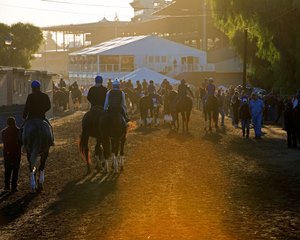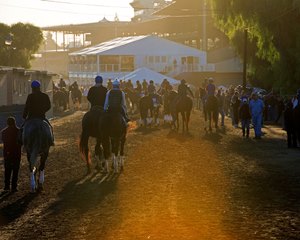Santa Anita to Close Main Track to Evaluate Safety


Management at Santa Anita Park, after discussions with the California Horse Racing Board related to an increased number of fatalities at the track this season, announced it would close its main track for training Feb. 26 "to fully evaluate sub-surface conditions, such as moisture content and soil consistency."
The announcement Feb. 24 said if that evaluation indicates "the track is in prime condition, regularly scheduled training will resume (Feb. 27) and live racing will proceed (Feb. 28)." The training track, which sits on the inside of the turf course, will remain open for training throughout the process. The announcement also said Mick Peterson, the director of the University of Kentucky's Agricultural Equine Programs who evaluates soil samples from Santa Anita on a monthly basis, will be on-site to review Santa Anita's main track. According to the announcement, Santa Anita track superintendent Andy LaRocco and his staff will "peel back the track’s cushion to a depth of approximately five inches, where a thorough examination of the base can be undertaken."
Initially, the decision to close the main track for training was announced on the overnight for the March 1 card at Santa Anita (which was published at about 3:15 p.m. PT, during Sunday's racing card), and the original plan was to close it for training Feb. 25 and Feb. 26 "due to renovations." That move was immediately opposed by multiple trainers who voiced those concerns to management, according to The Stronach Group's chief operating officer, Tim Ritvo. Ritvo said the group of trainers, which included Hall of Famers Jerry Hollendorfer and Bob Baffert, indicated they had important workouts scheduled for Monday and that they were "comfortable" working some of their best horses over the surface. That led to the track management's decision to allow for training Monday. Both Baffert and Hollendorfer were unavailable for comment Sunday afternoon.
Hollendorfer previously stated he plans to breeze OXO Racing's top 3-year-old Instagrand Monday, and jockey Javier Castellano is flying out from the East Coast to work the horse in preparation for the March 9 San Felipe Stakes (G2). On Feb. 23, the Hollendorfer-trained grade 1 winner Battle of Midway was one of two horses who were fatally injured during workouts on the main track.
BALAN: Battle of Midway Euthanized After Training Breakdown
"If they hadn't told me they were completely comfortable with it, we wouldn't be doing it," Ritvo said.
Ritvo emphasized he felt the track was safe but acknowledged the track's composition is different because of frequent and heavy rains this winter in California. Ritvo said the Santa Anita main track has more clay than East Coast tracks that handle rain better, and when heavy rains hit, the clay gets more compact.
"I honestly don't think there's a problem, but weather has been a factor," Ritvo said. "We had to float it (and seal it) a lot, so it's tighter than it has been. This is tough for us to do, but we're doing it as a precaution, even though we don't think there are any issues. The No. 1 reason I'm here is because I'm a horseman and the No. 1 priority is safety."
While equine fatalities are up over recent years, by seemingly all accounts from management, regulators, and horsemen, assigning blame to a racing surface as a reason for the increase in deaths is not clear-cut. According to the CHRB, since the beginning of Santa Anita's season Dec. 26 there have been 18 equine fatalities during racing or training, but they have been relatively spread out into different categories. From the 11 fatalities that have occurred because of injuries during racing, six have come from injuries on the main track and five have come from the turf. Of the seven fatalities from training, one was classified as a "sudden death" by the CHRB, meaning it was not related to a physical musculoskeletal injury. The other six were from injuries sustained on the main track, and none were associated with injuries on the training track. Through Feb. 23 in the last three seasons, the fatality numbers at Santa Anita were 10 in 2018 (three racing on dirt, three racing on turf, and four in training); eight in 2017 (four racing on dirt, two racing on turf, and two in training); and 14 in 2016 (four racing on dirt, two racing on turf, and eight in training).
"There are so many different factors. It's not just one thing," Ritvo said. "The track is obviously one factor, but there are so many other elements that go into it."
Ritvo admitted he was somewhat "nervous" that training will be conducted Monday, because even though he feels the main track is safe, the plan was to close it for training on that day and that was altered, so any type of injury sustained would compound what is already a complicated and emotional issue.
California Thoroughbred Trainers executive director Alan Balch said the horsemen's organization was not involved in the discussion with the CHRB Sunday or with the decision to close the main track for training. Balch also said he felt the main track was safe and that the CTT supports the decision to evaluate the racing surface, but expressed that the trainers were not pleased with the decision to close the track for training Monday with such late notice, and they voiced that sentiment, which led to the change to reopen the track for training until Tuesday.
"The (CHRB) and (Santa Anita) are doing what they believe they need to do to confirm the safety of the racetrack," Balch said.
Thoroughbred Owners of California president and CEO Greg Avioli was not available for comment on the issue Sunday.
When asked if they were concerned with racing on the main track for the late races on the card Sunday or with training on the main track Monday, considering the decision to close the track for training Tuesday, the CHRB stewards at Santa Anita declined to comment because they said they had not been informed of the decision to close the main track for training or the reasoning for the decision by Santa Anita's management, other than what was printed on the overnight.
In response to Santa Anita's announcement, the CHRB issued a statement that called its discussions with Santa Anita management "productive." The CHRB statement said those involved in the discussion from the CHRB side were chairman Chuck Winner, vice chair Madeline Auerbach, commissioner Alex Solis, and executive director Rick Baedeker. From Santa Anita, Ritvo and P.J. Campo, the executive vice president of racing for The Stronach Group, were involved in the discussion.
"CHRB will continue to monitor all aspects of Santa Anita's racing program, as we do at all tracks, and work with Santa Anita management and horsemen to promote safer racing," the CHRB statement said.
